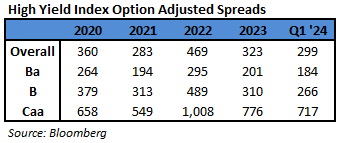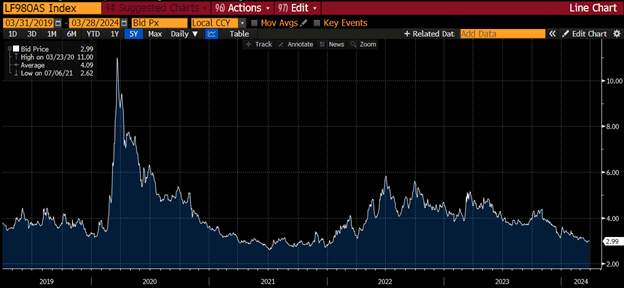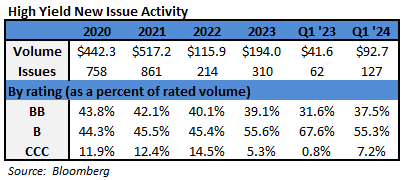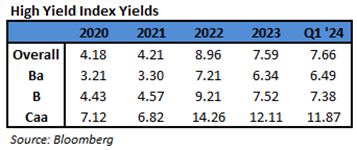2024 Q1 High Yield Quarterly
In the first quarter of 2024, the Bloomberg US Corporate High Yield Index (“Index”) return was 1.47%, and the S&P 500 index return was 10.55% (including dividends reinvested). Over the period, while the 10 year Treasury yield increased 32 basis points, the Index option adjusted spread (“OAS”) tightened 24 basis points moving from 323 basis points to 299 basis points.
All ratings segments of the High Yield Market participated in the spread tightening as BB rated securities tightened 17 basis points, B rated securities tightened 44 basis points, and CCC rated securities tightened 59 basis points. The chart below from Bloomberg displays the spread moves in the Index over the past five years. For reference, the average level over that time period was 409 basis points.
The sector and industry returns in this paragraph are all Index return numbers. The Index is mapped in a manner where the “sector” is broader with the more specific “industry” beneath it. For example, Energy is a “sector” and the “industries” within the Energy sector include independent energy, integrated energy, midstream, oil field services, and refining. The Other Financial, Brokerage, and Energy sectors were the best performers during the quarter, posting returns of 2.79%, 2.58%, and 2.55%, respectively. On the other hand, Communications, Utilities, and Insurance were the worst performing sectors, posting returns of -1.90%, 0.29%, and 0.32%, respectively. At the industry level, retailers, paper, and healthcare all posted the best returns. The retailers industry posted the highest return of 4.89%. The lowest performing industries during the quarter were wireless, cable, and media. The wireless industry posted the lowest return of -7.12%.
The year is off to a very strong start in terms of issuance. The $92.7 billion figure is the most volume in a quarter since the third quarter of 2021. Of the issuance that did take place during Q1, Financials took 25% of the market share followed by Discretionary at 23% share and Energy at 15% share.
The Federal Reserve did hold the Target Rate steady at the January and March meetings. There was no meeting held in February. This made five consecutive meetings without a hike. The last hike was back in July of 2023. The Fed dot plot shows that Fed officials are forecasting 75 basis points in cuts during 2024. Market participants have continued to reign in their own expectations of cuts during 2024 based on the pricing of Fed Funds Futures. At the start of the year, participants expected over 150 basis points in cuts during 2024; however, the expectation is now down to approximately 67 basis points in cuts this year.i During the March post meeting press conference, Chair Powell “largely shrugged off recent data showing an uptick in inflation in recent months, saying, ‘It is still likely in most people’s view that we will achieve that confidence and there will be rate cuts.’ At the same time, he said the data supported the Fed’s cautious approach to the first rate cut, and added that policymakers are still looking for more evidence that inflation is headed toward their 2% goal.”ii The Fed’s main objective has been lowering inflation and while now being described as “bumpy,” it continues to trend in the desired direction. The most recent report for Core CPI showed a year over year growth rate of 3.8% down from a peak of 6.6% a year and a half ago. Further, the most recent Core PCE growth rate measured 2.8% off the peak of 5.6% from February of 2022.
Intermediate Treasuries increased 32 basis points over the quarter, as the 10-year Treasury yield was at 3.88% on December 31st, and 4.20% at the end of the first quarter. The 5-year Treasury increased 36 basis points over the quarter, moving from 3.85% on December 31st, to 4.21% at the end of the first quarter. Intermediate term yields more often reflect GDP and expectations for future economic growth and inflation rather than actions taken by the FOMC to adjust the target rate. The revised fourth quarter GDP print was 3.4% (quarter over quarter annualized rate). Looking forward, the current consensus view of economists suggests a GDP for 2024 around 2.2% with inflation expectations around 2.9%.iii
Being a more conservative asset manager, Cincinnati Asset Management does not buy CCC and lower rated securities. Additionally, our interest rate agnostic philosophy keeps us generally positioned in the five to ten year maturity timeframe. During Q1, those elements were a drag on performance as lower rated securities outperformed and rate movements put our particular duration position at a disadvantage. Additional performance drag was due to our cash position and credit selections within the consumer and energy sectors. Benefiting our performance this quarter were our credit selections in the banking and technology sectors and our underweight in the communications sector.
The Bloomberg US Corporate High Yield Index ended the first quarter with a yield of 7.66%. Treasury volatility, as measured by the Merrill Lynch Option Volatility Estimate (“MOVE” Index), has picked up quite a bit the past couple of years. The MOVE averaged 121 during 2023 relative to a 62 average over 2021. However, the current rate of 86 is well below the spike near 200 back during the March 2023 banking scare. Data available through February shows 5 defaults during 2024 which is relative to 16 defaults in all of 2022 and 41 defaults in all of 2023. The trailing twelve month dollar-weighted default rate is 2.53%.iv The current default rate is relative to the 1.30%, 1.74%, 1.93%, 2.37% default rates from the previous four quarter end data points listed oldest to most recent. While defaults are ticking up, the fundamentals of high yield companies still look good. From a technical view, fund flows were positive in the quarter at $5.8 billion.v No doubt there are risks, but we are of the belief that for clients that have an investment horizon over a complete market cycle, high yield deserves to be considered as part of the portfolio allocation.
The market backdrop was fairly positive for high yield this quarter. The nice inflows, strong issuance, and good available yield led to a positive total return. However, there are under-currents to monitor as consumer spending ticks up while the savings rate ticks down, and consumer delinquencies are moving higher across most loan categories. Looking ahead, the approaching presidential election certainly has the ability to impact markets, and the Fed stands at the ready to begin cutting rates. Our exercise of discipline and credit selectivity is important as we continue to evaluate that the given compensation for the perceived level of risk remains appropriate. As always, we will continue our search for value and adjust positions as we uncover compelling situations. Finally, we are very grateful for the trust placed in our team to manage your capital.
This information is intended solely to report on investment strategies identified by Cincinnati Asset Management. Opinions and estimates offered constitute our judgment and are subject to change without notice, as are statements of financial market trends, which are based on current market conditions. This material is not intended as an offer or solicitation to buy, hold or sell any financial instrument. Fixed income securities may be sensitive to prevailing interest rates. When rates rise the value generally declines. Past performance is not a guarantee of future results. Gross of advisory fee performance does not reflect the deduction of investment advisory fees. Our advisory fees are disclosed in Form ADV Part 2A. Accounts managed through brokerage firm programs usually will include additional fees. Returns are calculated monthly in U.S. dollars and include reinvestment of dividends and interest. The index is unmanaged and does not take into account fees, expenses, and transaction costs. It is shown for comparative purposes and is based on information generally available to the public from sources believed to be reliable. No representation is made to its accuracy or completeness. Additional disclosures on the material risks and potential benefits of investing in corporate bonds are available on our website: https://www.cambonds.com/disclosure-statements/.
i Bloomberg March 29, 2024: World Interest Rate Probability
ii Bloomberg March 20, 2024: Fed Signals Three Rate Cuts Likely
iii Bloomberg March 29, 2024: Economic Forecasts (ECFC)
iv Moody’s March 14, 2024: February 2024 Default Report and data file
v CreditSights March 28, 2024: “Credit Flows”




